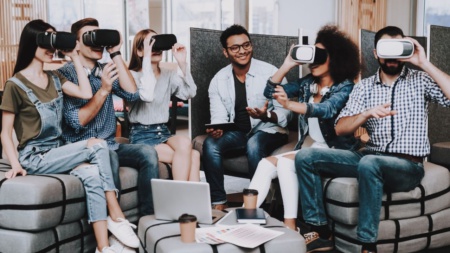I bought an Oculus Quest 2 in October 2021, and quickly became hooked on VR. I was so intrigued that I began searching for the best virtual reality headsets on the market. This blog post is the result of that comprehensive search.
1) Oculus Quest 2

The Oculus Quest 2 is the best commercially available VR headset right now, and it’s not particularly close. It has two killer features that most of the other headsets don’t have.
- It’s standalone (You don’t need a PC or to be tethered to it).
- It’s cheap (Its starting price-point is only $300).
The big one for me is that it’s a standalone device. I can’t imagine using a physical wire while playing most VR games. It’d completely kill the experience (mainly because I play workout games). And while the Quest 2 CAN play PC VR games via a wire, it doesn’t HAVE to.
The Quest 2 is also competitive on specs. The big one for me is the resolution of the screen. Around the time the Quest 2 was released, the only headset beating its resolution was the Reverb G2 which was selling for double the price (and doesn’t offer a standalone experience).
| Year Released | Headset | Pixels Per Degree Horizontal | Pixels Per Degree Vertical |
| 2016 | HTC VIVE | 10.5 | 9.8 |
| 2020 | STARVR ONE | 10.7 | 11.4 |
| 2016 | Oculus Rift CV1 | 12.5 | 11.5 |
| 2020 | Pimax Artisan | 13.2 | 11.6 |
| 2019 | Valve Index | 13.3 | 12.3 |
| 2020 | HTC Vive Pro | 14.7 | 12.7 |
| 2019 | Oculus Rift S | 14.9 | 13.1 |
| 2020 | Oculus Quest 2 | 19.9 | 15.5 |
| 2020 | HP Reverb G2 | 22.0 | 18.9 |
Before you get obsessed with this device list, know that I wouldn’t really recommend any of the headsets on the list (besides the Quest 2). Most of these headsets aren’t competitive on price, have lesser specs than the Quest 2, and don’t offer a standalone experience.
2) Pico Neo 3 Link
In mid-April 2022 the Pico Neo 3 Link was announced for sale in Europe for 450 Euros.
What’s special about this headset? Well… Not much really as it’s nearly identical in specs to a Quest 2.
That said, if you’re a PC VR enthusiast or you just hate Facebook so much that you outright refuse to buy a Quest 2 then I could see this headset being very appealing. That is until Fall of 2022 when I expect future headsets to blow this one away (see below).
3) Varjo Aero
The Varjo Aero barely makes the list because it’s the only commercially available PC VR headset with a PPD (pixel per degree) of 35! For those who don’t know, when you get to a pixel per degree of 35, it becomes difficult to visually distinguish virtual reality from reality.
You’ll be tethered to your PC and spending $2,000+ on what’s effectively a beta product. That said, if you want the best visual VR experience on the market today, this is what you can buy. And I desperately want one but can’t afford to fork over the cash for it right now.
Future Headsets (Fall 2022+)
If I were buying a headset today, I’d buy a Quest 2. And if I wanted the best resolution on the market and didn’t care about price (or standalone VR), I’d buy the Varjo Aero. And that’s the whole list of VR headsets I’d consider buying right now.
Competitive PC VR headsets exist, like the Vive Focus 3 ($1300), Reverb G2 ($600), and Pico Neo 3 Link (listed above). But unless you’re a PC VR enthusiast or fanatically hate Facebook as a company it’s difficult to recommend those headsets to anybody.
That said, in Fall of 2022, I expect the number of headsets on the market to increase. It looks like the following premium headsets are all going to drop and crush the Quest 2 on specs (but probably not on price).
4) Apple’s VR Headset
I debated whether to even mention this device. We only have vague rumors right now as to if Apple is really going to release a VR / AR headset.
That said, the rumor is that Apple is working on a high-end VR/AR device that will have the processing power of the M1 chip (which would blow the Quest 2 out of the water). If this device is real, then I desperately want to buy it over all of the other options. So start saving money now because Apple isn’t known for selling products at a discounted price.
5) Project Cambria by Meta (Facebook)
Facebook (now Meta) announced this device at Facebook connect 2021. The problem is they didn’t give us any details about it. We know that it will be a premium headset rather than a competitor to the Quest 2, that will have have some new lens technology, and that they plan to release it sometime in 2022.
That’s it; that’s seriously all they told us. Check the video below if you don’t believe me.
While I’d love to know more details, the Quest 2 is the best VR Headset on the market right now so I’m definitely interested in the premium version of it.
6) Pimax Reality 12k QLED
Another headset announced that won’t be released until Q4 2022. That said, Pimax did us a solid and announced the specs they plan this device to have, and they’re wild.
We’re talking a 210 degree Field of View, 6k QLED screen for each eye, motorized IPD adjustment, face/body tracking, and a standalone mode. This thing is hitting pretty much all the things I want to see in a VR headset (minus not having a better processor than the Quest 2).
At a projected $2400. It’s expensive, but on the spec sheet it’s currently the dominant force of what has been officially announced by any VR company. I fully expect Apple and Meta to have a competitive and maybe better offering. But, until those companies make their headsets official this is the most spec’d out future headset officially announced so far.
7) Arpara 5k VR Headset
The standalone version of this headset is rumored to ship for $599 in August of 2022.
Based on the specs, I would put it as a solid Quest 2 competitor. It has a better resolution than the Quest 2, and looks like a more comfortable device (plus it doesn’t tether you to Facebook, yay!).
The problem with this device is that by the time August of 2022 rolls around, Apple/Meta/Pimax’s new headsets will be just around the corner. There’s only a small window in time where this headset might be the best option.
What I’d Love To See in Future Headsets
The Quest 2 will blow away anybody who’s completely new to VR. That said, if I had a magic wand, I’d improve many things about it. The following is what I’m hoping to see in future VR headsets.
- Better Screens: No more LCD panels (something like OLED, QLED, etc. where you get true blacks)
- Better Resolutions: The low resolution of the Quest 2
- Better Lenses: Automatic IPD adjustment, less glare, fans for fog.
- Better Processor: The Snapdragon chip in the Quest 2 is about as powerful as an iPhone 11. I’d love to see Apple silicon in these devices for improved performance/battery life.
- Better Tracking: The cameras the Quest 2 uses for its Guardian system could be significantly improved. This would also enable features like hand, face, and foot tracking.
- Increased Field of View: For better immersion.
- Better Faceplates / straps / controllers/ etc: for obvious reasons.


